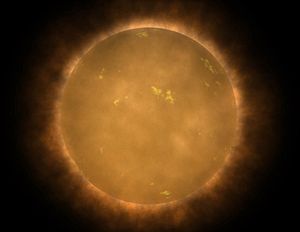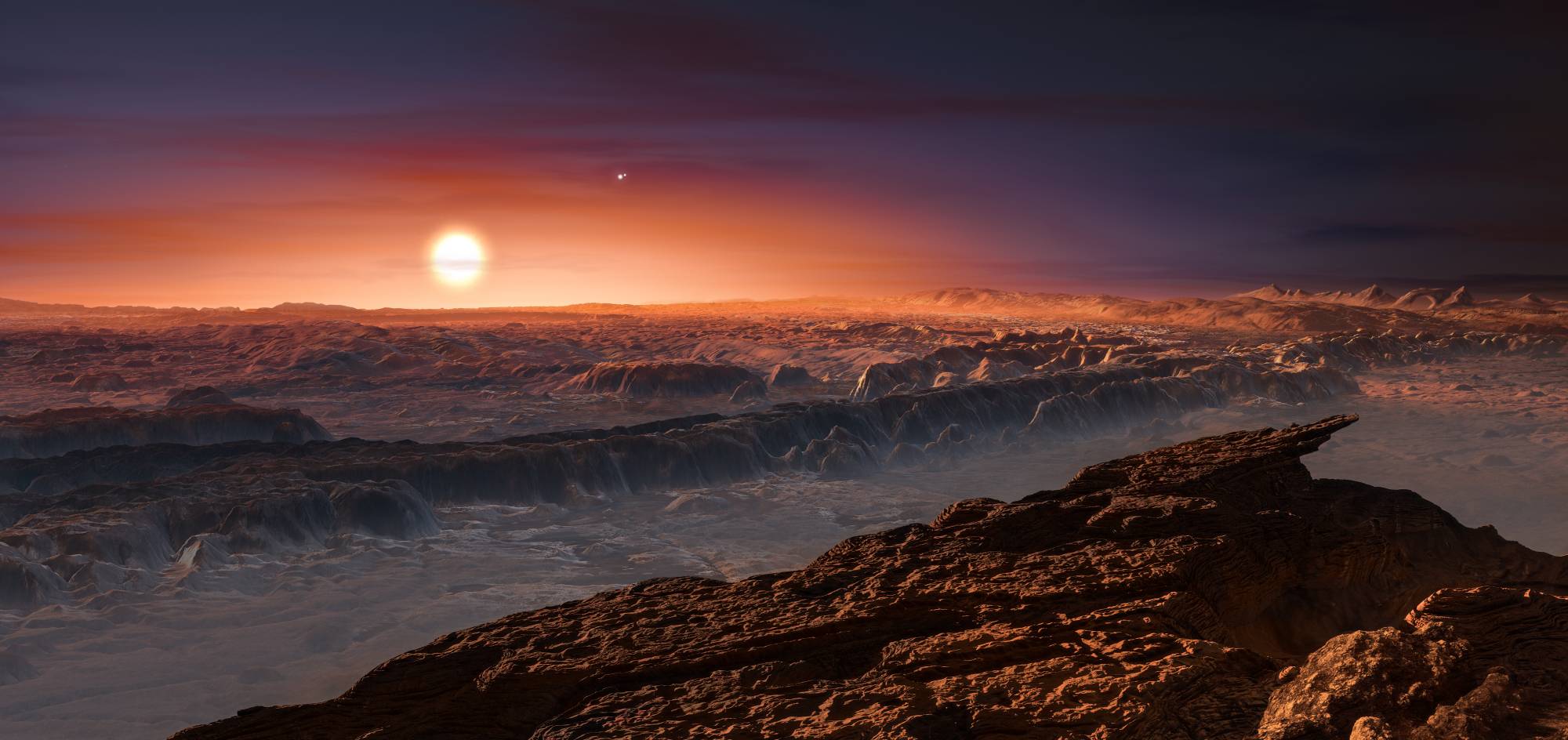Proxima b
Nearest Known Exoplanet
Proxima b is the nearest known exoplanet around the red dwarf star Proxima Centauri, the smallest of a triple star system at a distance of 4.24 light-years in Centaurus. Orbiting at a distance of merely 0.05AU, which is inside the star's HBZ, a year on Proxima b lasts 11.186 days. The planet has an estimated mass of at least 1.27 terran and is believed to be a rocky warm world which, even given its unknown atmospherics, is unlikely to be habitable due to strong stellar wind pressures as well as harmful radiation. The star with a luminosity about 0.0015 solar also emits strong flares. Daylight on the planet is as dim as twilight on Earth while the equilibrium temperature is around -39°C.
Image credit: ESO/M. KornmesserPosted on: 2018-11-26
Overview
| Planet Designation | Title | Constellation | Distance | SMA | Period | Mass | Radius | Year | |
|---|---|---|---|---|---|---|---|---|---|
| 1 | Proxima b | Nearest Known Exoplanet | Centaurus | 4.24ly | 0.04856AU | 11.1868d | 1.27⊕ | 2016 | |
| 2 | Barnard b | Second Closest Known Exoplanet | Ophiuchus | 5.9ly | AU | d | 3.23⊕ | ||
| 3 | Epsilon Eridani b | Asteroid Belts and Controversal Planets | Eridanus | 10.48ly | 3.53AU | 2671d | 245⊕ | 2000 | |
| 4 | Ross 128 b | Third Closest Known Exoplanet | Virgo | 11.03ly | 0.0496AU | 9.8658d | 1.35⊕ | 2017 | |
| 5 | Tau Ceti e | Planets Needing Confirmation | Cetus | 11.91ly | 0.538AU | 162.87d | 3.29⊕ | 2017 | |
| 6 | Luyten's Star b | Only 1.2 Light-Years Away from Procyon | Canis Minor | 12.2ly | 0.091101AU | 18.6498d | 2.89⊕ | 2017 | |
| 7 | Kapteyn's Star c | Oldest-known Cold Exoplanet | Pictor | 12.76ly | 0.311AU | 121.54d | 4.8⊕ | 2014 | |
| 8 | Wolf 1061 c | Temperate Super-Earth or Super-Mars | Ophiuchus | 14.04ly | 0.089AU | 17.8719d | 3.41⊕ | 2015 | |
| 9 | Gliese 832 c | Large Planet as Temperate as Earth | Grus | 16.1ly | AU | d | 5.4⊕ | ||
| 10 | 40 Eridani b | Hot Super-Earth in Triple Star System | Eridanus | 16.26ly | 0AU | 42.378d | 8.47⊕ | 2018 | |
| 11 | Gliese 3323 b | Little Known in Habitable Zone | Eridanus | 17.54ly | 0.03282AU | 5.3636d | 2.02⊕ | 2017 | |
| 12 | LTT 1445A b | Planet in Triple Red Dwarf System | Eridanus | 22.5ly | 0.022AU | 5.35876d | 2.2⊕ | 1.18⊕ | 2019 |
| 13 | Gliese 667C c | Earth-like Planet in Triple Star System | Scorpius | 23.6ly | 0.125AU | 28.14d | 3.71⊕ | 2013 | |
| 14 | HD 85512 b | Bordering the Habitable Zone | Vela | 36.4ly | 0.26AU | 58.43d | 3.6⊕ | 2011 | |
| 15 | Gliese 1132 b | Heat Planet with Atmosphere | Vela | 39.3ly | 0.0153AU | 1.62893d | 1.66⊕ | 1.13⊕ | 2015 |
| 16 | Trappist-1 d | Small but Most Earth-like Known Planet | Aquarius | 39.5ly | 0.02227AU | 4.04922d | 0.297⊕ | 0.78⊕ | 2016 |
| 17 | LHS 1140 b | A Massive Super-Earth Inside Habitable Zone | Cetus | 40.67ly | 0.0946AU | 24.7372d | 6.64⊕ | 1.72⊕ | 2017 |
| 18 | Gliese 143 b | A Huge Neptunian Around a K-Star | Reticulum | 53.2ly | 0.1915AU | 35.6125d | 30.63⊕ | 2.61⊕ | 2019 |
| 19 | TOI-270 b | Nearby M-Dwarf Planets | Dorado | 73.23ly | AU | d | 1.9⊕ | ||
| 20 | Gliese 3470 b | Evaporating Planet | Cancer | 95.5ly | 0.0355AU | 3.33665d | 13.4⊕ | 4.57⊕ | 2012 |
| 21 | K2-3 b | Super-Earths Trio in Leo | Leo | 143.9ly | 0.0747AU | 10.0547d | 2.7⊕ | 2.07⊕ | 2015 |
| 22 | HIP 11915 b | A Twin of Jupiter | Cetus | 175ly | AU | d | 0.99⊕ | ||
| 23 | K2-288B b | Detected by Citizen Scientists | Taurus | 226ly | 0.164AU | 31.3935d | 4⊕ | 1.90⊕ | 2018 |
| 24 | Kepler-186 f | Earth-sized Cold Kepler Planet | Cygnus | 582ly | 0.432AU | 129.944d | 1.4⊕ | 1.16⊕ | 2014 |
Red Dwarfs in a Nutshell
Most of the stars introduced on this page are 'Red Dwarfs'. Actually they represent the most common type of stars. About 73% of all stars in the Milky Way galaxy are dim red dwarfs, featuring less than half the solar surface temperature and low luminosity, but in turn high stellar activity, such as flares and hazardous radiation that can hit red dwarf planets hard potentially prohibiting formation of known lifeforms.
Given its minute energy emission, the habitable zone (HBZ, an imaginary ring where temperatures support liquid water) of a red dwarf is situated near the star, as are planets orbiting inside this zone. The gravitational pull of the star can tidally lock a nearby planet which then faces one hemisphere to the star while the other is enshrouded in darkness - like the Earth moon - the axial rotation period equals the orbital period.
Some densely populated systems, such as TRAPPIST-1, have several planets orbiting in close proximity in that an observer on a planet could see other planets larger than our moon in the sky. Also, the planet may have one or multiple moons themselves. In any case a truly impressive spectacle with fast changes.

Likelihood of life low because:
- Low stellar energy flux
- Tidal lock, tidal heating
- Narrow habitable zone
- Stellar variations, flares, stellar 'wind' of charged particles
On the other hand, if conditions are favorable:
- A red dwarf is aged, known for longevity while some are rather inactive.
- The lower the mass of a red dwarf the longer it will 'live', potentially trillions of years.
- A planet mass big enough to hold an atmosphere capable of heat transfer.
- A low orbit eccentricity for stable meteorological conditions.
- Planets at the outer edge of the HBZ can retain water.
- Planet may have a solid core and a magnetic field shield.
- Lots of known lifeforms on Earth developed and are living under brutal conditions.
Observation
Due to their low visual luminosity no known red dwarf is visible by the naked eye, not even the nearest such as Proxima Centauri or the solitary Barnard's Star. Others, such as Gliese 667, are triple star systems but anywhere near visual magnitude
Image Credit: NASA/ESA/STScl

























